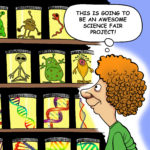By Carol Cleland (University of Colorado Boulder)
Cite as: Cleland, C. (2022) “The Problem with Agnostic Biosignatures””. Primordial Scoop, e20220421. https://doi.org/10.52400/EQSF5472
This is a follow up on David Grinspoon’s blog. I agree with pretty much everything he says. It is interesting that NASA believes that moving from a definition-based approach to so-called “agnostic biosignatures” somehow solves the challenge of searching for life as we don’t know it. The central problem is that we don’t have access to truly agnostic biosignatures. The only example of life with which we have experience is a single example, descended from a last universal common ancestor and, moreover, adapting and evolving under the time-ordered sequence of particular environmental conditions present during the history of planet Earth. One cannot generalize to all life based on a single example of life, especially when there are positive reasons to suspect that it may be unrepresentative of life considered generally.
This is why I have advocated, in several papers and my recent book (Quest for a Universal theory of Life), for a (dare I say) less definitive search strategy, namely, searching for potentially biologicalanomalies (vs. life per se) using tentative criteria (which would include a variety of characteristics of familiar Earth life, both general and specific to certain environments, along with characteristics that are rarely found among nonliving physicochemical phenomena). Such a strategy would go a long way towards helping researchers recognize a form of life that fails to (as David says) “follow our script”.
The worry about encountering a form of life that fails to conform to our current Earthcentric biases about the nature of life is even more serious than David suggests. As the history of science reveals, anomalies—phenomena that don’t fit readily into widely accepted classification schemes—are rarely recognized as such when first encountered. Indeed, it sometimes takes years for them to be deemed other than merely puzzling and sometimes they aren’t even recognized as puzzling.
A good illustration is the discovery of Uranus, which was classified as a star by earlier astronomers, who failed to recognize that its characteristics (being disk shaped and moving among vs. with the stars) were anomalous until Herschel famously pointed this out to them. Once this happened these same astronomers, using the same telescopes with which they had initially “seen” (and documented) a star saw that it wasn’t star-like after all. Herschel initially classified it is a comet because, as Kuhn persuasively argues, he didn’t believe that there were any planets beyond Saturn. Once attention was drawn to its anomalousness qua star, Lexell studied the orbit, made some calculations, and announced that it was planetary (vs. cometary). It seems that Herschel just assumed that it was cometary because of his background belief that Saturn was the furthest planet from the Sun. The “discovery” of Uranus the planet illustrates the tendency to force anomalous phenomena into widely accepted categories, in effect, rendering them “invisible” as such.
Another, more contemporary, illustration is the discovery of giant viruses, which was delayed by ten years because of the widely accepted belief among biologists that viruses are tiny in virtue of not requiring molecular mechanisms for metabolism and reproduction (since they reproduce by invading and commandeering the genetic and metabolic mechanisms of cells); giant viruses were thus initially classified as tiny bacteria. Once the first giant viruses were recognized as such even larger giant viruses were “discovered”, some on the scale of small parasitic bacteria. Almost certainly, these larger viruses had been previously observed but not recognized as viruses because they failed to fit a widely accepted biological dogma about viruses and bacteria. The history of science is full of examples like this. Using the adjective ‘agnostic’ amounts to a mere verbal strategy for hiding the fact that the proposed biosignatures are just as Earthcentric as a definition of life and hence just as likely to mislead astrobiologists encountering phenomena that differ from familiar life in novel (unanticipated) ways. The upshot is that life that fails to follow “our script” will most likely to be classified by supposedly agnostic biosignatures as abiotic.



